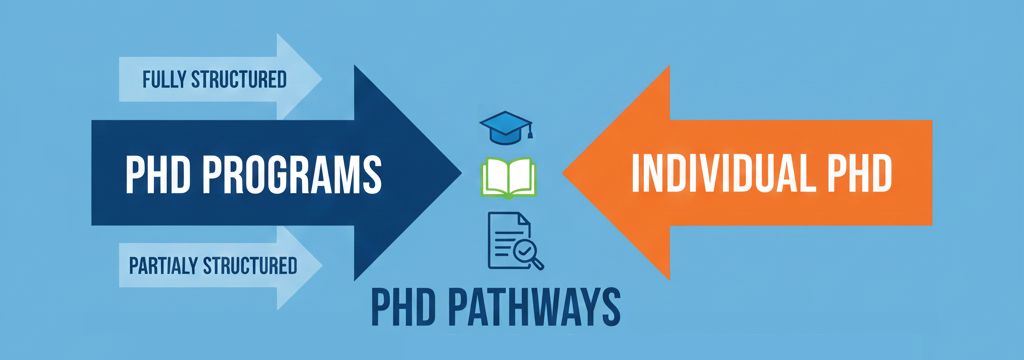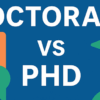
Why does the doctorate vs PhD debate exist? Many people assume a PhD and a doctorate are the same, but this is a misconception in many fields. A PhD is one type of doctorate, specifically a research-focused degree, with a dissertation that contributes to the advancement of knowledge in a research area, preparing students for academic and research-oriented job positions. For example, disciplines in STEM fields typically culminate in a PhD. While other doctoral degree branches (i.e., professional doctorates and first professional degrees) represent the highest academic degree in certain fields, they prepare students for professional practices as company leaders, lawyers, general practitioners, etc. This article explores the doctorate vs PhD and distinct doctoral titles in detail.
Doctorate vs PhD: 3 Major Doctoral Categories
Selecting the appropriate academic or career path requires an understanding of the various kinds of doctoral categories. Despite the widespread belief that all “doctorates” have the same function, doctoral education actually falls into three major categories, each with unique career paths and outcomes. The most well-known route is the PhD, which is a research doctorate focused on generating new knowledge via scientific investigation and research. Professional doctorates, on the other hand, concentrate on using advanced research to fulfill real-world leadership positions in particular industries. Lastly, graduates with first professional degrees are eligible for licensure in highly regulated professions like law or medicine. Examining these categories makes it easier to determine which degree best suits individual objectives.

What is a PhD?
PhD is the abbreviation of the Latin term Philosophiae Doctor, which translates to Doctor of Philosophy in English. It represents the highest degree level in many academic fields, e.g., STEM, education, humanities, and others. This prestigious qualification centers around a rigorous research-based endeavor, where candidates delve into the realms of original and substantial contributions to their chosen field. A cornerstone of this journey is writing a dissertation, often spanning 200-300 pages or 60,000-100,000 words. Ultimately, it must undergo a rigorous oral examination (viva) before a panel of examiners. A full-time PhD journey typically takes 3-6 years. It prepares graduates for careers in academia as professors. Still, they are also valuable for research-intensive roles in industry and government institutions.
What is a Professional Doctorate?
Under this category, the doctorate vs PhD discussion is no longer valid. In most non-STEM fields, such as education, public health, business administration, design, and arts, students typically pursue professional doctorates rather than PhDs. Examples include Doctor of Education (EdD), Doctor of Design (DDes), and Doctor of Arts (DA). Professional doctorates are designed for experienced practitioners seeking advanced leadership and applied research skills within their profession. Unlike PhD programs, which focus on original research, professional doctorates emphasize solving real-world problems using evidence-based strategies. Coursework focuses on management, innovation, policy, and organizational transformation, culminating in an applied dissertation or capstone project that demonstrates impact in professional practice. Graduates pursue senior executive roles, clinical practice, educational leadership, and policy development.
What is a First Professional Degree?
In regulated fields like medicine, dentistry, law, pharmacy, and veterinary science, first professional degrees (e.g., MD, JD, DDS, and PharmD) prepare students for licensure and clinical or legal practice. Despite having the title of “Doctor”/”Dr.”, these degrees differ greatly from academic doctoral programs, where they emphasize professional practices over the production of scholarly research. To guarantee that graduates fulfill stringent industry standards and legal requirements for practice, programs combine in-depth theoretical coursework with practical clinical or hands-on training. Their goal is to prepare skilled professionals to provide knowledgeable services to society, not to increase knowledge through research. Under this category, the doctorate vs PhD discussion is also not valid.
What Fields Offer both PhD and Professional Doctorate?
Depending on their career goals, students can choose between a research-driven PhD and a practice-oriented professional doctorate. Education, business management, psychology, social work, public health, nursing, engineering, physical therapy, and fine arts or design are among the common fields that offer both professional doctoral pathways and PhDs. In these disciplines, the terms “professional doctorate” and “PhD” do not overlap and are not interchangeable. They allow students to select either a professional track that focuses on using advanced research to lead innovation in practice (for a professional doctorate) or an academic track that focuses on producing original research and contributing new knowledge (for a PhD). For example, EdD vs PhD in education is a dilemma for education students.
Doctorate vs PhD Conclusion
Understanding the difference between PhD and doctorate is essential to selecting the best doctoral pathway. Despite being regarded as advanced credentials, each has a unique function in further education and professional advancement. The goal of a PhD is to increase knowledge through original research, typically leading to careers in academia or research. Professional doctorates, however, prepare graduates for advanced leadership roles in professional settings by applying research to solve real-world problems. First professional degrees, on the other hand, offer the credentials needed to obtain a license in a regulated profession like law or medicine. Students can match their educational choices with their long-term professional objectives and aspirations by being aware of these differences.
Table 1. Doctorate vs PhD distinctions at a glance.
| Category | Research Focus | Practice Focus | Licensure Requirement | Dissertation Writing? | Dissertation Defense? |
|---|---|---|---|---|---|
| PhDs | ✅ | ❌ | ❌ | ✅ | ✅ |
| Professional Doctorates | ✅ (applied) | ✅ | ✅ (sometimes) | ✅ (applied) | ✅ |
| First Professional Degrees | ❌ | ✅ | ✅ | ❌ | ❌ (but, clinical examinations or licensing exams) |
Frequently Asked Questions (FAQs)
Is a PhD the same as a doctorate?
Yes and No! The answer to the doctorate vs PhD misconception is: a PhD is one type of doctorate, specifically focused on research and academic contributions. Other types (professional doctorates and first professional degrees) focus on advanced professional practice rather than research.
Which is harder: a PhD or a professional doctorate?
Both are equally demanding but in different ways. A PhD emphasizes original research, academic writing, and theoretical depth, while a professional doctorate focuses on applying advanced knowledge to solve real-world professional problems.
Which doctorate is highest in rank?
Both PhDs and professional doctorates are terminal degrees. The “highest” depends on the career path: academic vs professional practice.
Can I call myself “Doctor”/”Dr.” with a professional doctorate?
Yes. Holders of both PhD and professional doctorate degrees are entitled to use the title “Doctor”/”Dr.”. However, in academic settings, the Doctor of Philosophy is usually associated with research expertise, while professional doctorates signal specialized professional mastery.
Can a professional doctorate lead to teaching at universities?
Yes, especially in practice-focused disciplines, but a PhD is generally preferred for research-intensive academic positions.
Which degree should I choose between professional doctorate and PhD?
It depends on your career goals. Choose a PhD if you aim for an academic or research career. Choose a professional doctorate if you want to advance as a practitioner, executive, or industry leader in your professional field.
Are first professional degrees considered doctorates?
They use the title “Doctor”/”Dr.”, but academically, they are not considered research or scholarly doctorates.
Do all doctoral students write a dissertation?
PhDs always do. Most professional doctorates include a dissertation or applied project. First professional degrees usually do not.
Which doctoral path is best for earning potential?
It depends on the field! Physicians, dentists, pharmacists, and lawyers often earn more in clinical or legal practice, while research careers vary by discipline.





Leave Your Comment